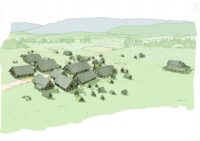 Archaeologists have unearthed a full Merovingian settlement complete with church and burial ground in Pontarlier, eastern France. Grave goods including weapons and jewelry indicate the settlement was a prosperous one, not a sleepy pastoral village.
Archaeologists have unearthed a full Merovingian settlement complete with church and burial ground in Pontarlier, eastern France. Grave goods including weapons and jewelry indicate the settlement was a prosperous one, not a sleepy pastoral village.
It was strategically located near the village of Pontarlier, formerly the ancient waystation of Ariolica on the Roman road between modern-day Orbe, Switzerland, and Besançon, France. Pontarlier became even more important after the Burgundian invasions of the 5th century as a key trading center linking Burgundy’s territories to Switzerland, German and Lombard northern Italy. It was also the only reliable pass over the Jura Mountains well into the 17th century.
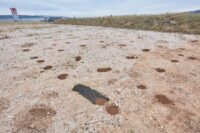 The site was occupied for 150 to 200 years in the 6th and 7th centuries. The settlement was built quickly according to a plan found in Germanic territories from this period in Switzerland and Bavaria, but never before in France. Ten large rectangular buildings were at the center, each supported by massive corner poles three feet in diameter. These large structures had two distinct areas: one half partitioned into smaller spaces, the other half wide open. The former is believed to have been the living space for humans, the latter for animals.
The site was occupied for 150 to 200 years in the 6th and 7th centuries. The settlement was built quickly according to a plan found in Germanic territories from this period in Switzerland and Bavaria, but never before in France. Ten large rectangular buildings were at the center, each supported by massive corner poles three feet in diameter. These large structures had two distinct areas: one half partitioned into smaller spaces, the other half wide open. The former is believed to have been the living space for humans, the latter for animals.
The church was built a little ways apart from the large dwellings and the smaller structures at the center of the village. Based on the size and position of the postholes, we know the church was a wooden building about 65 feet long and 46 feet wide designed on a basilica plan. It is one of the oldest churches in the Jura Mountains and its architecture is unique in the area for its time. No other examples are known in France or Switzerland.
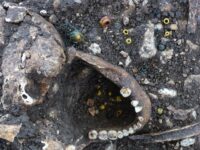 One tomb was found inside the church, and three more next to it. The prime location indicates these may have been members of the family that founded the village and/or sponsored the construction of the church. The women buried near the church were laid to rest with expensive jewelry like a fibula with cloisonné garnets, gold-plated earrings and glass beads. Another 70 graves were unearthed located in different spots throughout the settlement.
One tomb was found inside the church, and three more next to it. The prime location indicates these may have been members of the family that founded the village and/or sponsored the construction of the church. The women buried near the church were laid to rest with expensive jewelry like a fibula with cloisonné garnets, gold-plated earrings and glass beads. Another 70 graves were unearthed located in different spots throughout the settlement.
The settlement’s economy appears to have revolved around raising 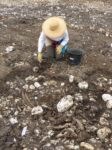 livestock. A cattle slaughter site a few thousand square feet in area has been found a few yards from the village. Radiocarbon dating results confirm that it was in use at the time the village was occupied in the 7th century. Of the thousands of bones at the slaughter site, most are from oxen and horses. The village likely bred the livestock for slaughter.
livestock. A cattle slaughter site a few thousand square feet in area has been found a few yards from the village. Radiocarbon dating results confirm that it was in use at the time the village was occupied in the 7th century. Of the thousands of bones at the slaughter site, most are from oxen and horses. The village likely bred the livestock for slaughter.
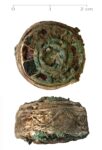 The non-local house plans, the rapid founding and growth of the village suggests the population was transplanted, not naturally evolved in the area. This was a frequent practice for conquering peoples like the Burgundians and Franks. They seeded their new territories with their own people, and this spot at a key transit area for trade between Italy and France would have been crucial to claim and control as quickly as possible.
The non-local house plans, the rapid founding and growth of the village suggests the population was transplanted, not naturally evolved in the area. This was a frequent practice for conquering peoples like the Burgundians and Franks. They seeded their new territories with their own people, and this spot at a key transit area for trade between Italy and France would have been crucial to claim and control as quickly as possible.
The site was abandoned as quickly as it was built. The departures appear to have been orderly and non-violent, so the population was either consolidated with that of Pontarlier or moved away for other reasons (easier defense, better economic opportunity, etc.).
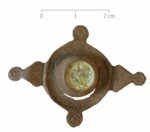
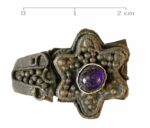
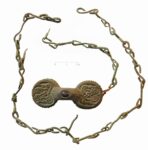
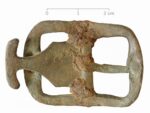

Or maybe they were wiped out by subsequent waves of the plague of Justinian that were still happening in the 7th century?
In 777, pro-Abbasid rulers of northern Spain requested help against the powerful Umayyad Emirate of Cordoba in southern Spain, led by Abd ar-Rahman.
Therefore, Sulayman al-Arabi the pro-Abbasid governor of Barcelona and Girona sent a delegation to Charlemagne in Paderborn, offering his submission, together with the allegiance of Husayn of Zaragoza and Abu Taur of Huesca in return for military aid.
The Umayyad conquest of the Visigothic Kingdom, had been the initial expansion of the Umayyad Caliphate over Hispania. Those pro-Abbasid rulers also conveyed that the caliph of Baghdad was preparing an invasion force against the Umayyad ruler. Following the sealing of this alliance at Paderborn, King Carl marched across the Pyrenees in 778 at the head of all the forces he could muster.
———–
AD DCCLXXVIII. “Tunc domnus Carolus rex iter peragens partibus Hispaniae per duas vias; una per Pampilonam, per quam ipse supradictus magnus rex perrexit usque Caesaraugustam. Ibique venientes de partibus Burgundiae et Austriae vel Baioariae seu Provinciae et Septimaniae et pars Langobardorum; et coniungentes se ad supradictam civitatem ex utraque parte exercitus. Ibi obsides receptos de Ibin al Arabi et de Abutauro et de multis Sarracenis, Pampilona destructa, Hispani Wascones subiugatos, etiam et Nabarros, reversus in partibus Franciae.”
———–
Apparently the train went on southwards –actually two trains, of which the eastern one went via parts of Burgundia– in an attempt to “liberate” Caesaraugusta / Zaragoza, but the whole thing ended ‘reversus in partibus Franciae’.
496 – 843: Frankish Empire / Merovingian duchy
During the Merovingian Frankish empire and the Karolingian Frankish empire nobles often created local churches or monasteries. In return for doing this they often got the right to choose the priest or abbot (either directly or later a veto vote).